Level 8 Research: Volunteer Perception at Make-A-Wish New Zealand
VerifiedAdded on 2023/04/22
|28
|5931
|303
Report
AI Summary
This research report explores volunteer perceptions of career growth and social engineering within the non-profit organization Make-A-Wish New Zealand. It investigates the factors that motivate volunteers and their perceptions of career advancement opportunities. The study utilizes qualitative research methods, including interviews, to gather primary data from Make-A-Wish volunteers. The literature review examines professional development in non-profit organizations, volunteering experiences, volunteer commitment and engagement, and motivational work. The research aims to provide insights into how non-profit organizations manage their human resources and benefit future scholars in people management strategies. Desklib provides access to this assignment and many more to aid students in their studies.
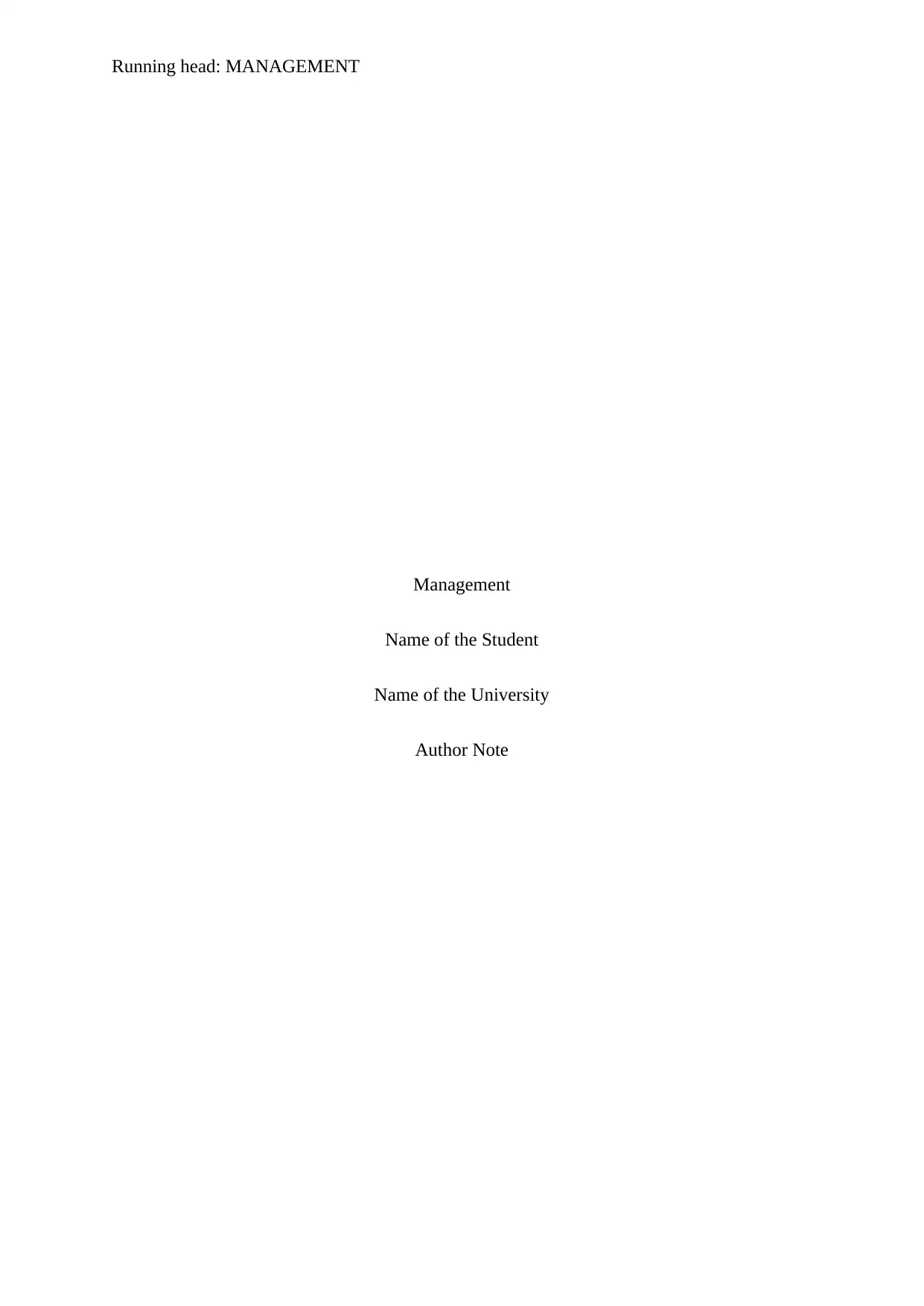
Running head: MANAGEMENT
Management
Name of the Student
Name of the University
Author Note
Management
Name of the Student
Name of the University
Author Note
Paraphrase This Document
Need a fresh take? Get an instant paraphrase of this document with our AI Paraphraser
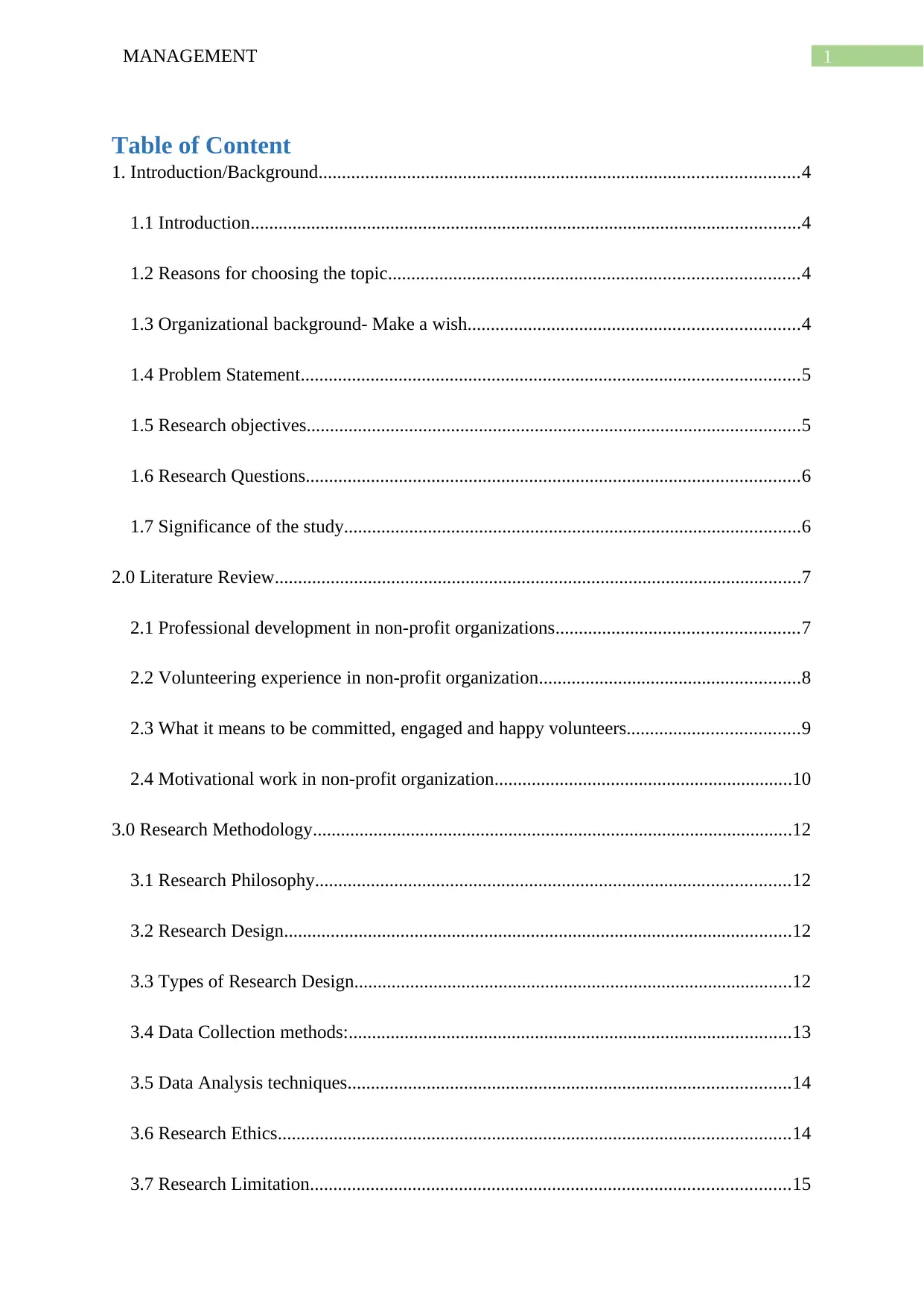
1MANAGEMENT
Table of Content
1. Introduction/Background.......................................................................................................4
1.1 Introduction......................................................................................................................4
1.2 Reasons for choosing the topic........................................................................................4
1.3 Organizational background- Make a wish.......................................................................4
1.4 Problem Statement...........................................................................................................5
1.5 Research objectives..........................................................................................................5
1.6 Research Questions..........................................................................................................6
1.7 Significance of the study..................................................................................................6
2.0 Literature Review.................................................................................................................7
2.1 Professional development in non-profit organizations....................................................7
2.2 Volunteering experience in non-profit organization........................................................8
2.3 What it means to be committed, engaged and happy volunteers.....................................9
2.4 Motivational work in non-profit organization................................................................10
3.0 Research Methodology.......................................................................................................12
3.1 Research Philosophy......................................................................................................12
3.2 Research Design.............................................................................................................12
3.3 Types of Research Design..............................................................................................12
3.4 Data Collection methods:...............................................................................................13
3.5 Data Analysis techniques...............................................................................................14
3.6 Research Ethics..............................................................................................................14
3.7 Research Limitation.......................................................................................................15
Table of Content
1. Introduction/Background.......................................................................................................4
1.1 Introduction......................................................................................................................4
1.2 Reasons for choosing the topic........................................................................................4
1.3 Organizational background- Make a wish.......................................................................4
1.4 Problem Statement...........................................................................................................5
1.5 Research objectives..........................................................................................................5
1.6 Research Questions..........................................................................................................6
1.7 Significance of the study..................................................................................................6
2.0 Literature Review.................................................................................................................7
2.1 Professional development in non-profit organizations....................................................7
2.2 Volunteering experience in non-profit organization........................................................8
2.3 What it means to be committed, engaged and happy volunteers.....................................9
2.4 Motivational work in non-profit organization................................................................10
3.0 Research Methodology.......................................................................................................12
3.1 Research Philosophy......................................................................................................12
3.2 Research Design.............................................................................................................12
3.3 Types of Research Design..............................................................................................12
3.4 Data Collection methods:...............................................................................................13
3.5 Data Analysis techniques...............................................................................................14
3.6 Research Ethics..............................................................................................................14
3.7 Research Limitation.......................................................................................................15

2MANAGEMENT
3.8 Research Plan.................................................................................................................15
References................................................................................................................................18
Appendices...............................................................................................................................22
Questionnaire.......................................................................................................................22
Example Participant Information Sheet...................................................................................22
Overview of the Participant Information sheet..................................................................22
Study Title...............................................................................................................................23
Invitation paragraph..............................................................................................................23
What is the purpose of the study?......................................................................................24
3.8 Research Plan.................................................................................................................15
References................................................................................................................................18
Appendices...............................................................................................................................22
Questionnaire.......................................................................................................................22
Example Participant Information Sheet...................................................................................22
Overview of the Participant Information sheet..................................................................22
Study Title...............................................................................................................................23
Invitation paragraph..............................................................................................................23
What is the purpose of the study?......................................................................................24
⊘ This is a preview!⊘
Do you want full access?
Subscribe today to unlock all pages.

Trusted by 1+ million students worldwide

3MANAGEMENT
Abstract
This proposed study is analysis of volunteers’ perception of career growth and social
engineering in non-profit organization –Make a Wish located in New Zealand. The study will
include a primary research analysis. Primary data will be collected from volunteers from
Make A Wish. To collect the data qualitative data, interview method will be applied to the
study. A review of volunteers’ perception and commitment towards non-profit organizations
have been performed in this report which indicates that existing studies lack insight in terms
of employee motivation and employee development programs application to non-profit
organizations.
Abstract
This proposed study is analysis of volunteers’ perception of career growth and social
engineering in non-profit organization –Make a Wish located in New Zealand. The study will
include a primary research analysis. Primary data will be collected from volunteers from
Make A Wish. To collect the data qualitative data, interview method will be applied to the
study. A review of volunteers’ perception and commitment towards non-profit organizations
have been performed in this report which indicates that existing studies lack insight in terms
of employee motivation and employee development programs application to non-profit
organizations.
Paraphrase This Document
Need a fresh take? Get an instant paraphrase of this document with our AI Paraphraser
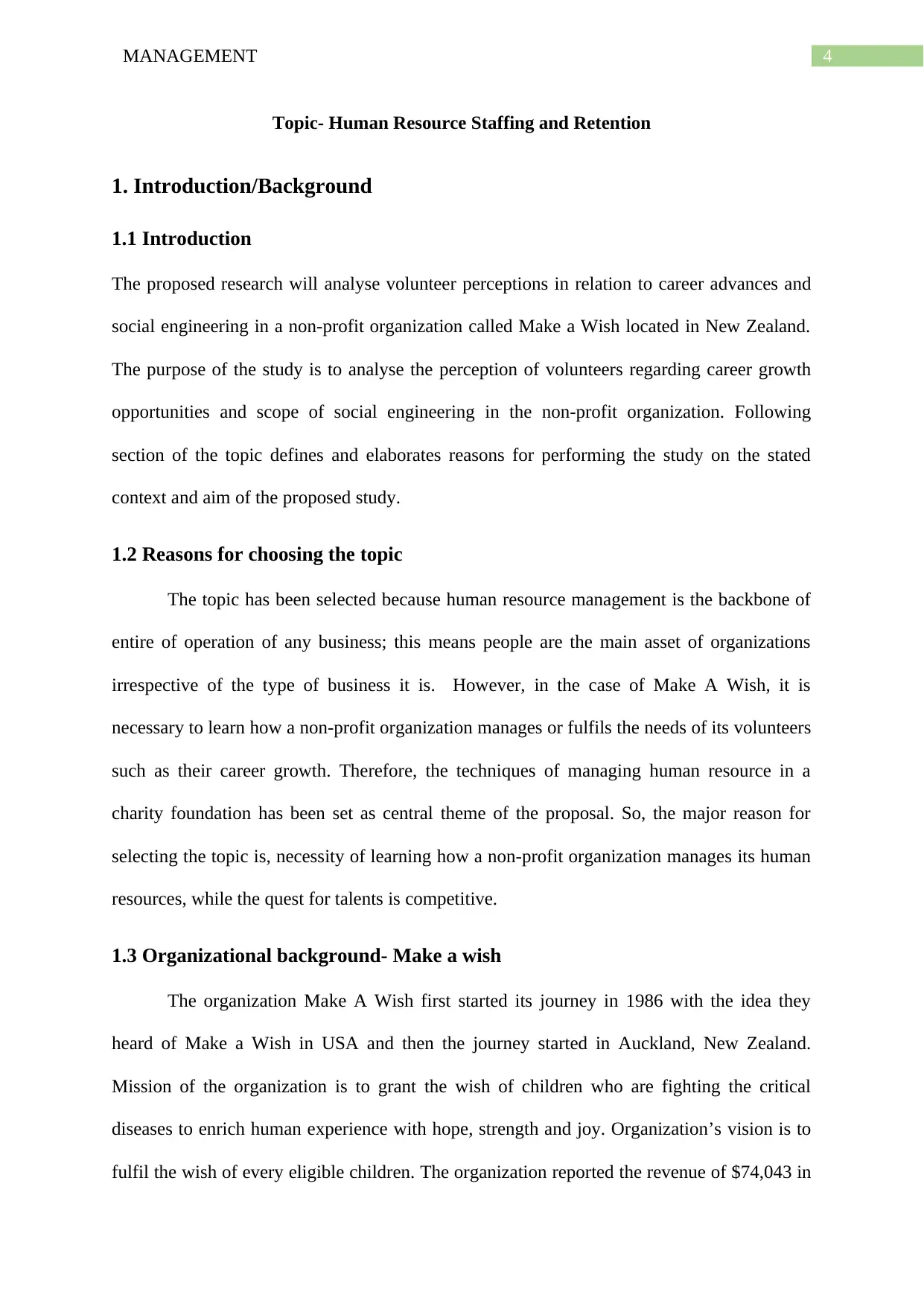
4MANAGEMENT
Topic- Human Resource Staffing and Retention
1. Introduction/Background
1.1 Introduction
The proposed research will analyse volunteer perceptions in relation to career advances and
social engineering in a non-profit organization called Make a Wish located in New Zealand.
The purpose of the study is to analyse the perception of volunteers regarding career growth
opportunities and scope of social engineering in the non-profit organization. Following
section of the topic defines and elaborates reasons for performing the study on the stated
context and aim of the proposed study.
1.2 Reasons for choosing the topic
The topic has been selected because human resource management is the backbone of
entire of operation of any business; this means people are the main asset of organizations
irrespective of the type of business it is. However, in the case of Make A Wish, it is
necessary to learn how a non-profit organization manages or fulfils the needs of its volunteers
such as their career growth. Therefore, the techniques of managing human resource in a
charity foundation has been set as central theme of the proposal. So, the major reason for
selecting the topic is, necessity of learning how a non-profit organization manages its human
resources, while the quest for talents is competitive.
1.3 Organizational background- Make a wish
The organization Make A Wish first started its journey in 1986 with the idea they
heard of Make a Wish in USA and then the journey started in Auckland, New Zealand.
Mission of the organization is to grant the wish of children who are fighting the critical
diseases to enrich human experience with hope, strength and joy. Organization’s vision is to
fulfil the wish of every eligible children. The organization reported the revenue of $74,043 in
Topic- Human Resource Staffing and Retention
1. Introduction/Background
1.1 Introduction
The proposed research will analyse volunteer perceptions in relation to career advances and
social engineering in a non-profit organization called Make a Wish located in New Zealand.
The purpose of the study is to analyse the perception of volunteers regarding career growth
opportunities and scope of social engineering in the non-profit organization. Following
section of the topic defines and elaborates reasons for performing the study on the stated
context and aim of the proposed study.
1.2 Reasons for choosing the topic
The topic has been selected because human resource management is the backbone of
entire of operation of any business; this means people are the main asset of organizations
irrespective of the type of business it is. However, in the case of Make A Wish, it is
necessary to learn how a non-profit organization manages or fulfils the needs of its volunteers
such as their career growth. Therefore, the techniques of managing human resource in a
charity foundation has been set as central theme of the proposal. So, the major reason for
selecting the topic is, necessity of learning how a non-profit organization manages its human
resources, while the quest for talents is competitive.
1.3 Organizational background- Make a wish
The organization Make A Wish first started its journey in 1986 with the idea they
heard of Make a Wish in USA and then the journey started in Auckland, New Zealand.
Mission of the organization is to grant the wish of children who are fighting the critical
diseases to enrich human experience with hope, strength and joy. Organization’s vision is to
fulfil the wish of every eligible children. The organization reported the revenue of $74,043 in
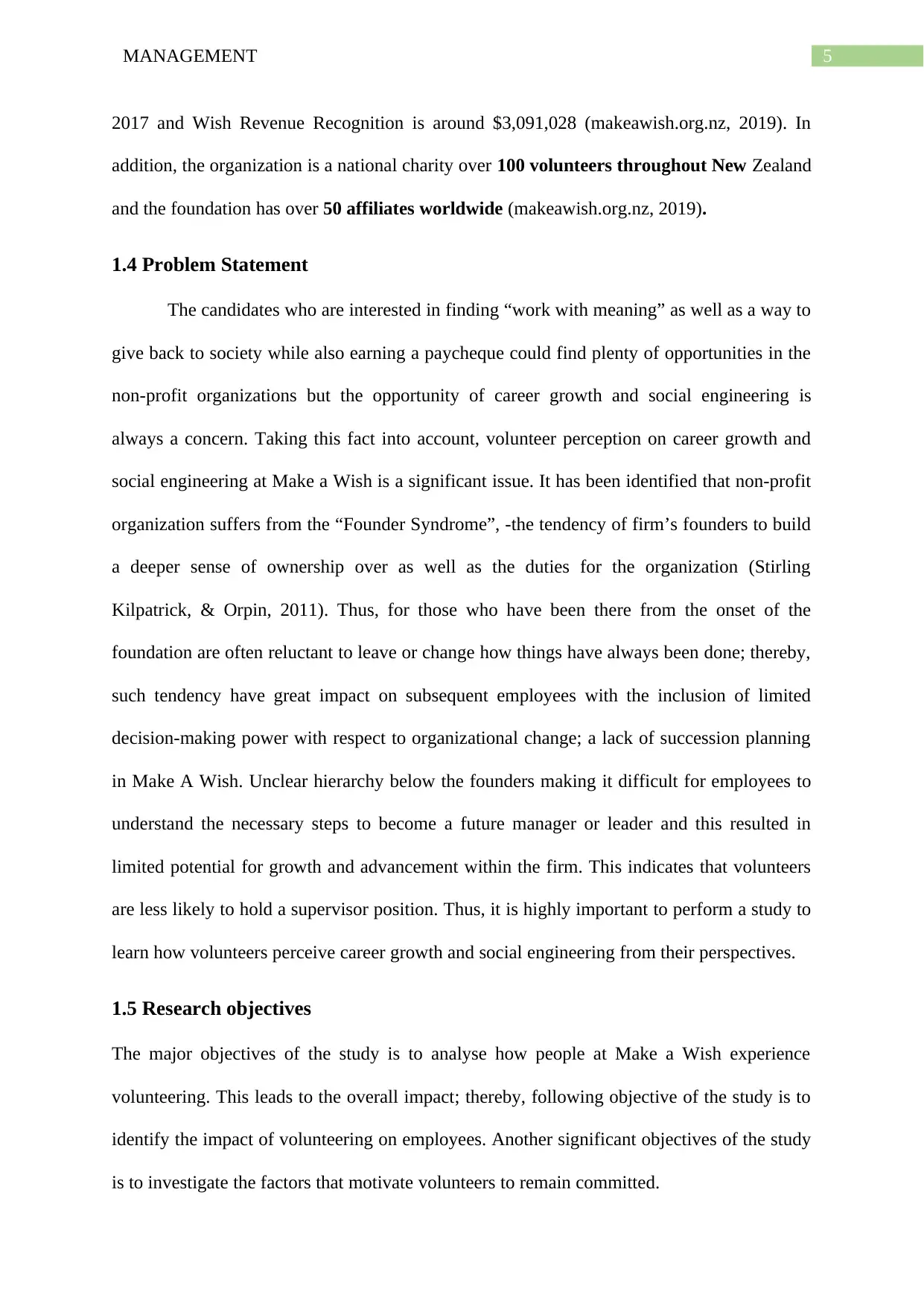
5MANAGEMENT
2017 and Wish Revenue Recognition is around $3,091,028 (makeawish.org.nz, 2019). In
addition, the organization is a national charity over 100 volunteers throughout New Zealand
and the foundation has over 50 affiliates worldwide (makeawish.org.nz, 2019).
1.4 Problem Statement
The candidates who are interested in finding “work with meaning” as well as a way to
give back to society while also earning a paycheque could find plenty of opportunities in the
non-profit organizations but the opportunity of career growth and social engineering is
always a concern. Taking this fact into account, volunteer perception on career growth and
social engineering at Make a Wish is a significant issue. It has been identified that non-profit
organization suffers from the “Founder Syndrome”, -the tendency of firm’s founders to build
a deeper sense of ownership over as well as the duties for the organization (Stirling
Kilpatrick, & Orpin, 2011). Thus, for those who have been there from the onset of the
foundation are often reluctant to leave or change how things have always been done; thereby,
such tendency have great impact on subsequent employees with the inclusion of limited
decision-making power with respect to organizational change; a lack of succession planning
in Make A Wish. Unclear hierarchy below the founders making it difficult for employees to
understand the necessary steps to become a future manager or leader and this resulted in
limited potential for growth and advancement within the firm. This indicates that volunteers
are less likely to hold a supervisor position. Thus, it is highly important to perform a study to
learn how volunteers perceive career growth and social engineering from their perspectives.
1.5 Research objectives
The major objectives of the study is to analyse how people at Make a Wish experience
volunteering. This leads to the overall impact; thereby, following objective of the study is to
identify the impact of volunteering on employees. Another significant objectives of the study
is to investigate the factors that motivate volunteers to remain committed.
2017 and Wish Revenue Recognition is around $3,091,028 (makeawish.org.nz, 2019). In
addition, the organization is a national charity over 100 volunteers throughout New Zealand
and the foundation has over 50 affiliates worldwide (makeawish.org.nz, 2019).
1.4 Problem Statement
The candidates who are interested in finding “work with meaning” as well as a way to
give back to society while also earning a paycheque could find plenty of opportunities in the
non-profit organizations but the opportunity of career growth and social engineering is
always a concern. Taking this fact into account, volunteer perception on career growth and
social engineering at Make a Wish is a significant issue. It has been identified that non-profit
organization suffers from the “Founder Syndrome”, -the tendency of firm’s founders to build
a deeper sense of ownership over as well as the duties for the organization (Stirling
Kilpatrick, & Orpin, 2011). Thus, for those who have been there from the onset of the
foundation are often reluctant to leave or change how things have always been done; thereby,
such tendency have great impact on subsequent employees with the inclusion of limited
decision-making power with respect to organizational change; a lack of succession planning
in Make A Wish. Unclear hierarchy below the founders making it difficult for employees to
understand the necessary steps to become a future manager or leader and this resulted in
limited potential for growth and advancement within the firm. This indicates that volunteers
are less likely to hold a supervisor position. Thus, it is highly important to perform a study to
learn how volunteers perceive career growth and social engineering from their perspectives.
1.5 Research objectives
The major objectives of the study is to analyse how people at Make a Wish experience
volunteering. This leads to the overall impact; thereby, following objective of the study is to
identify the impact of volunteering on employees. Another significant objectives of the study
is to investigate the factors that motivate volunteers to remain committed.
⊘ This is a preview!⊘
Do you want full access?
Subscribe today to unlock all pages.

Trusted by 1+ million students worldwide
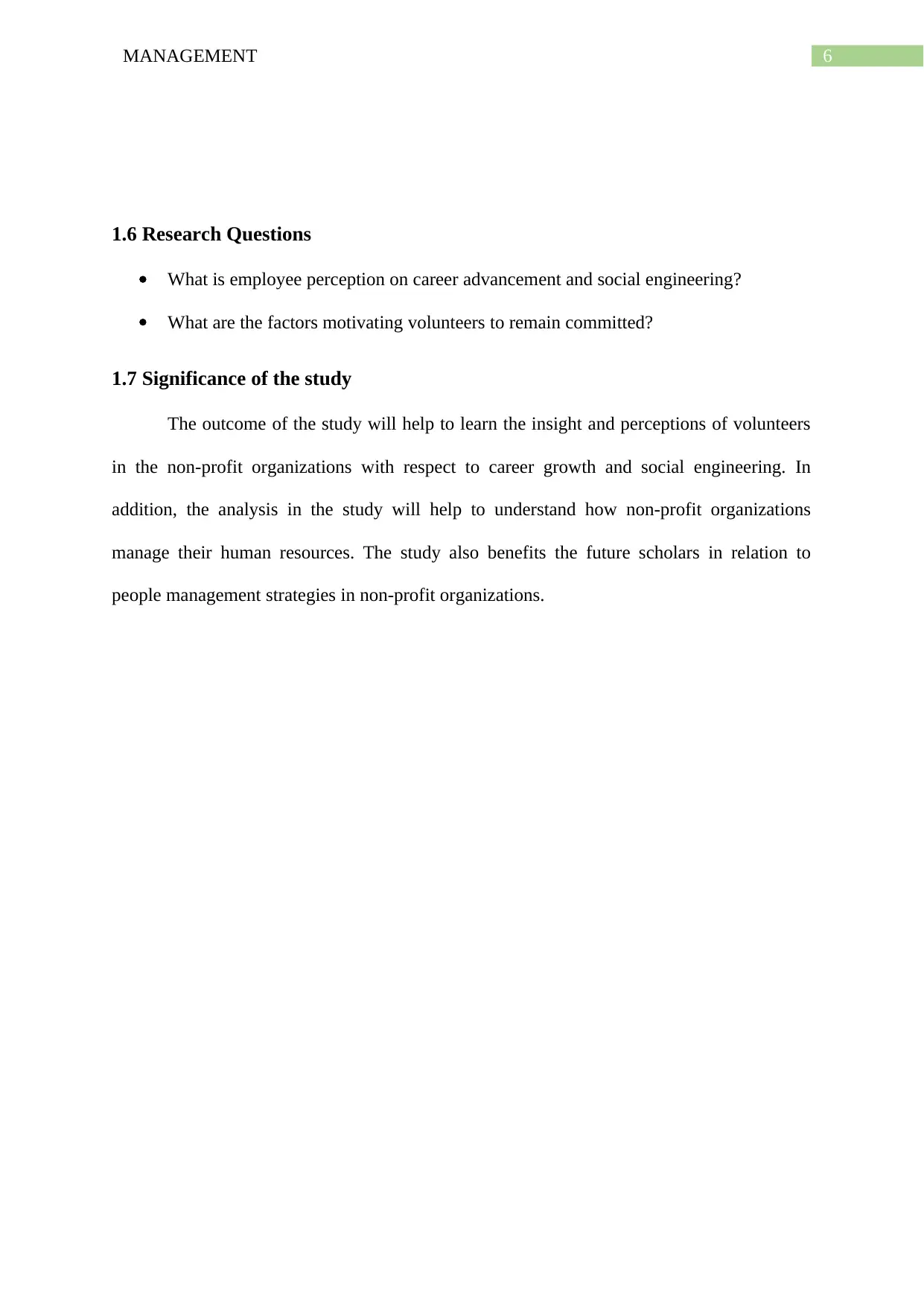
6MANAGEMENT
1.6 Research Questions
What is employee perception on career advancement and social engineering?
What are the factors motivating volunteers to remain committed?
1.7 Significance of the study
The outcome of the study will help to learn the insight and perceptions of volunteers
in the non-profit organizations with respect to career growth and social engineering. In
addition, the analysis in the study will help to understand how non-profit organizations
manage their human resources. The study also benefits the future scholars in relation to
people management strategies in non-profit organizations.
1.6 Research Questions
What is employee perception on career advancement and social engineering?
What are the factors motivating volunteers to remain committed?
1.7 Significance of the study
The outcome of the study will help to learn the insight and perceptions of volunteers
in the non-profit organizations with respect to career growth and social engineering. In
addition, the analysis in the study will help to understand how non-profit organizations
manage their human resources. The study also benefits the future scholars in relation to
people management strategies in non-profit organizations.
Paraphrase This Document
Need a fresh take? Get an instant paraphrase of this document with our AI Paraphraser
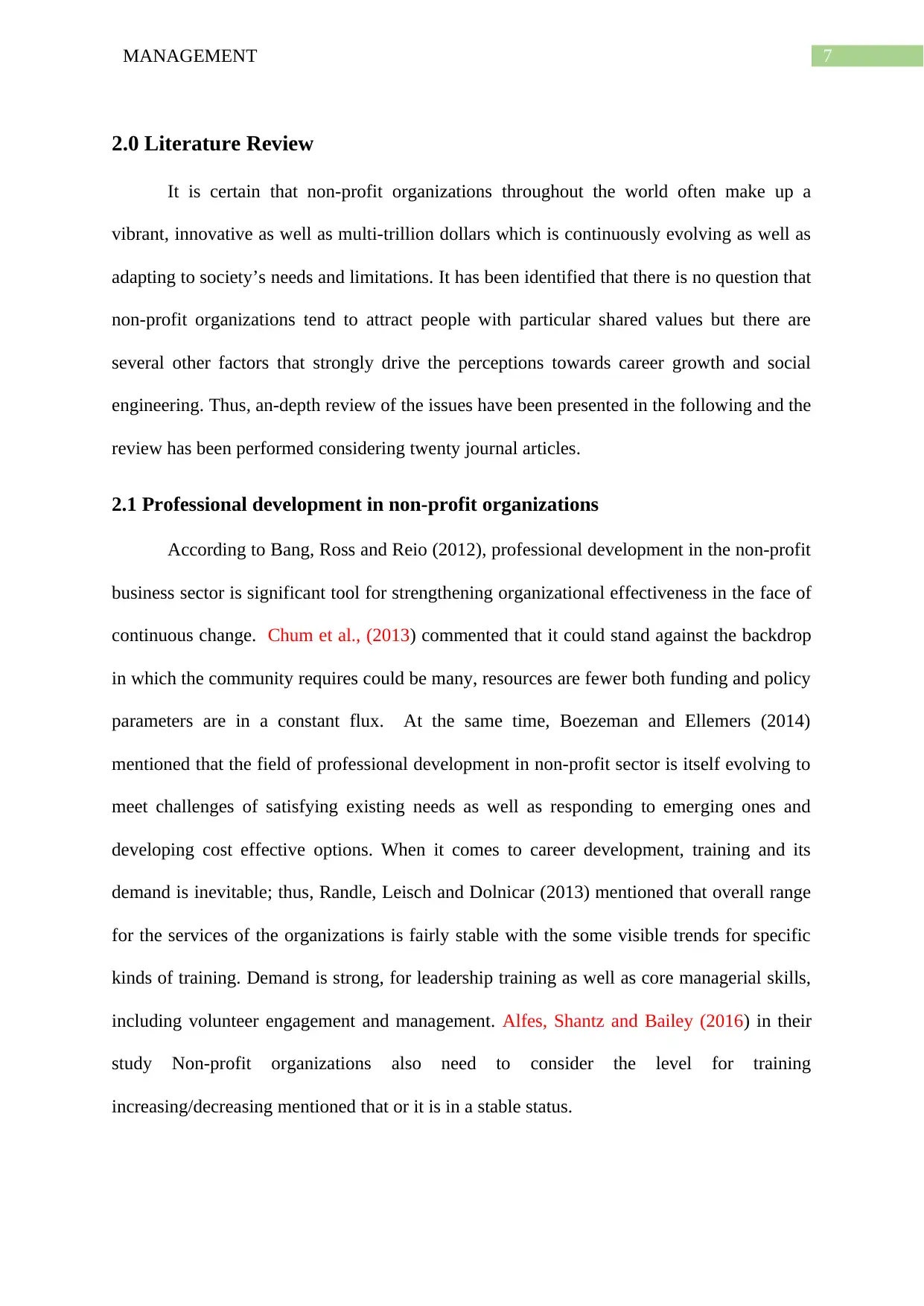
7MANAGEMENT
2.0 Literature Review
It is certain that non-profit organizations throughout the world often make up a
vibrant, innovative as well as multi-trillion dollars which is continuously evolving as well as
adapting to society’s needs and limitations. It has been identified that there is no question that
non-profit organizations tend to attract people with particular shared values but there are
several other factors that strongly drive the perceptions towards career growth and social
engineering. Thus, an-depth review of the issues have been presented in the following and the
review has been performed considering twenty journal articles.
2.1 Professional development in non-profit organizations
According to Bang, Ross and Reio (2012), professional development in the non-profit
business sector is significant tool for strengthening organizational effectiveness in the face of
continuous change. Chum et al., (2013) commented that it could stand against the backdrop
in which the community requires could be many, resources are fewer both funding and policy
parameters are in a constant flux. At the same time, Boezeman and Ellemers (2014)
mentioned that the field of professional development in non-profit sector is itself evolving to
meet challenges of satisfying existing needs as well as responding to emerging ones and
developing cost effective options. When it comes to career development, training and its
demand is inevitable; thus, Randle, Leisch and Dolnicar (2013) mentioned that overall range
for the services of the organizations is fairly stable with the some visible trends for specific
kinds of training. Demand is strong, for leadership training as well as core managerial skills,
including volunteer engagement and management. Alfes, Shantz and Bailey (2016) in their
study Non-profit organizations also need to consider the level for training
increasing/decreasing mentioned that or it is in a stable status.
2.0 Literature Review
It is certain that non-profit organizations throughout the world often make up a
vibrant, innovative as well as multi-trillion dollars which is continuously evolving as well as
adapting to society’s needs and limitations. It has been identified that there is no question that
non-profit organizations tend to attract people with particular shared values but there are
several other factors that strongly drive the perceptions towards career growth and social
engineering. Thus, an-depth review of the issues have been presented in the following and the
review has been performed considering twenty journal articles.
2.1 Professional development in non-profit organizations
According to Bang, Ross and Reio (2012), professional development in the non-profit
business sector is significant tool for strengthening organizational effectiveness in the face of
continuous change. Chum et al., (2013) commented that it could stand against the backdrop
in which the community requires could be many, resources are fewer both funding and policy
parameters are in a constant flux. At the same time, Boezeman and Ellemers (2014)
mentioned that the field of professional development in non-profit sector is itself evolving to
meet challenges of satisfying existing needs as well as responding to emerging ones and
developing cost effective options. When it comes to career development, training and its
demand is inevitable; thus, Randle, Leisch and Dolnicar (2013) mentioned that overall range
for the services of the organizations is fairly stable with the some visible trends for specific
kinds of training. Demand is strong, for leadership training as well as core managerial skills,
including volunteer engagement and management. Alfes, Shantz and Bailey (2016) in their
study Non-profit organizations also need to consider the level for training
increasing/decreasing mentioned that or it is in a stable status.

8MANAGEMENT
2.2 Volunteering experience in non-profit organization
Newton, Becker and Bell (2014) performed a study and mentioned the fact that
among a myriad of things that make volunteers happy performing the tasks are good
orientation to the organization as well as basic training. Authors mention the fact that just
getting volunteers at the doorstep is not sufficient; this means just like any other employee, a
volunteer needs to feel welcomed, trained and informed for whatever might occur. On the
other side, Do Paço, Agostinho and Nave (2013) mentioned that orientation is just like it
sounds; volunteers expect to know the context in which they could be doing their work.
According to Nencini, Romaioli and Meneghini (2016) even though there are unplanned and
sporadic episodes of volunteering work, volunteerism is often defined as the long-term,
planned and pro-social behaviour that often provide a set of benefits to strangers and takes
place within an organizational setting. However, Posner (2015) insisted on the fact that as a
form of social participation that tend to promote a sense of community as well as citizenship
and a kind of social action to serve the general good. In contrast, O'Boyle and Hassan (2014)
mentioned the fact that people continuous act in ways that benefit not only themselves as
individuals but also larger communities and the society of which they are members to
contribute to development of social capital with respect to both social links as well as civic
behaviour.
According Osborne (2013) several community, civic and governmental organizations
require and use volunteers to achieve their social goals. Alongside, the supply chain of
volunteer labour never seem to be sufficient to satisfy the demands of organizations
according to the reports given in the article. In such context, Vecina and Chacón (2013)
mentioned about the significant challenge which is about ensuing that volunteers remain
satisfied as well as committed sufficiently to fulfil such required positions in the community
programs. There are certain possibilities derived from this article –such as volunteers tend to
2.2 Volunteering experience in non-profit organization
Newton, Becker and Bell (2014) performed a study and mentioned the fact that
among a myriad of things that make volunteers happy performing the tasks are good
orientation to the organization as well as basic training. Authors mention the fact that just
getting volunteers at the doorstep is not sufficient; this means just like any other employee, a
volunteer needs to feel welcomed, trained and informed for whatever might occur. On the
other side, Do Paço, Agostinho and Nave (2013) mentioned that orientation is just like it
sounds; volunteers expect to know the context in which they could be doing their work.
According to Nencini, Romaioli and Meneghini (2016) even though there are unplanned and
sporadic episodes of volunteering work, volunteerism is often defined as the long-term,
planned and pro-social behaviour that often provide a set of benefits to strangers and takes
place within an organizational setting. However, Posner (2015) insisted on the fact that as a
form of social participation that tend to promote a sense of community as well as citizenship
and a kind of social action to serve the general good. In contrast, O'Boyle and Hassan (2014)
mentioned the fact that people continuous act in ways that benefit not only themselves as
individuals but also larger communities and the society of which they are members to
contribute to development of social capital with respect to both social links as well as civic
behaviour.
According Osborne (2013) several community, civic and governmental organizations
require and use volunteers to achieve their social goals. Alongside, the supply chain of
volunteer labour never seem to be sufficient to satisfy the demands of organizations
according to the reports given in the article. In such context, Vecina and Chacón (2013)
mentioned about the significant challenge which is about ensuing that volunteers remain
satisfied as well as committed sufficiently to fulfil such required positions in the community
programs. There are certain possibilities derived from this article –such as volunteers tend to
⊘ This is a preview!⊘
Do you want full access?
Subscribe today to unlock all pages.

Trusted by 1+ million students worldwide
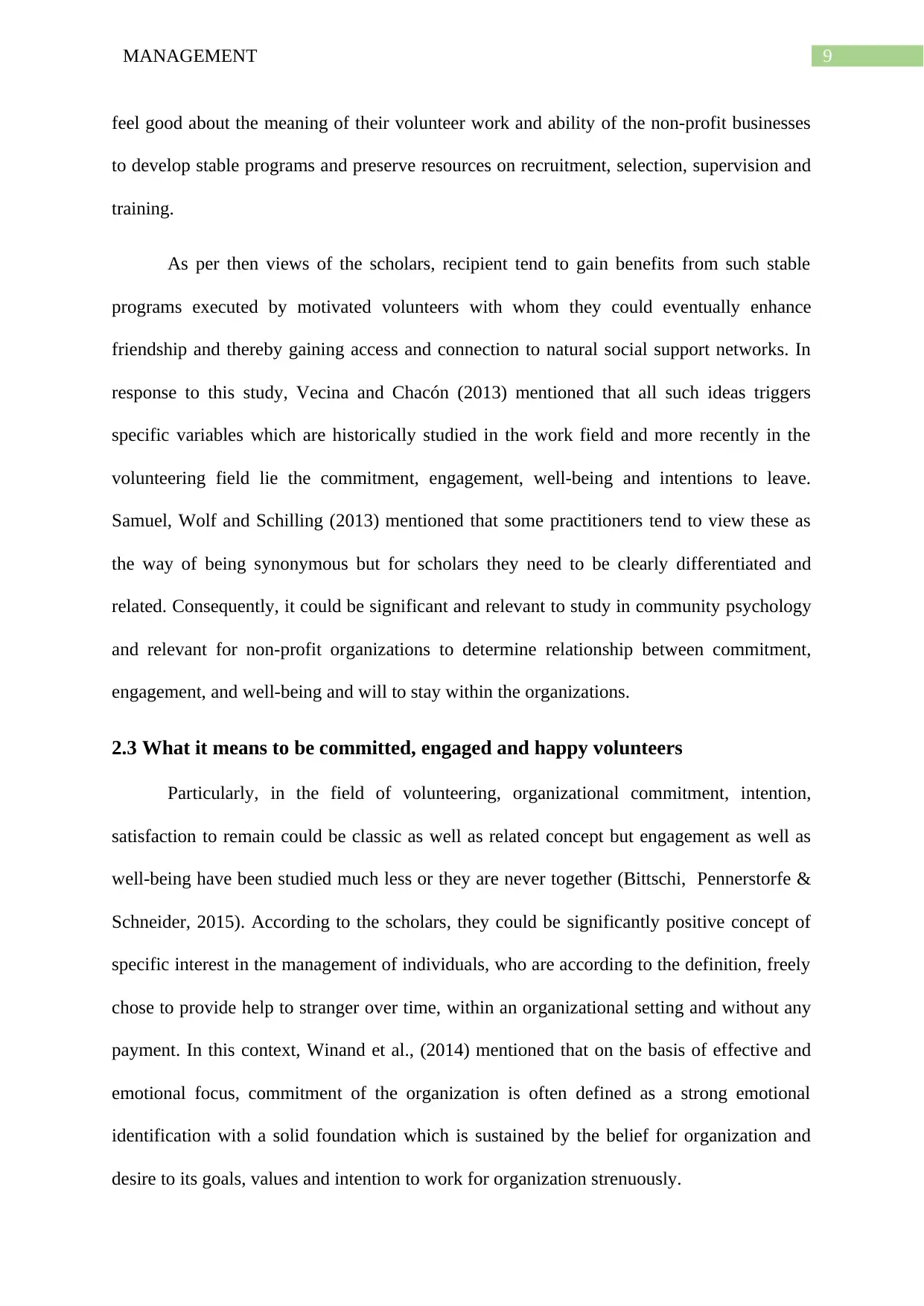
9MANAGEMENT
feel good about the meaning of their volunteer work and ability of the non-profit businesses
to develop stable programs and preserve resources on recruitment, selection, supervision and
training.
As per then views of the scholars, recipient tend to gain benefits from such stable
programs executed by motivated volunteers with whom they could eventually enhance
friendship and thereby gaining access and connection to natural social support networks. In
response to this study, Vecina and Chacón (2013) mentioned that all such ideas triggers
specific variables which are historically studied in the work field and more recently in the
volunteering field lie the commitment, engagement, well-being and intentions to leave.
Samuel, Wolf and Schilling (2013) mentioned that some practitioners tend to view these as
the way of being synonymous but for scholars they need to be clearly differentiated and
related. Consequently, it could be significant and relevant to study in community psychology
and relevant for non-profit organizations to determine relationship between commitment,
engagement, and well-being and will to stay within the organizations.
2.3 What it means to be committed, engaged and happy volunteers
Particularly, in the field of volunteering, organizational commitment, intention,
satisfaction to remain could be classic as well as related concept but engagement as well as
well-being have been studied much less or they are never together (Bittschi, Pennerstorfe &
Schneider, 2015). According to the scholars, they could be significantly positive concept of
specific interest in the management of individuals, who are according to the definition, freely
chose to provide help to stranger over time, within an organizational setting and without any
payment. In this context, Winand et al., (2014) mentioned that on the basis of effective and
emotional focus, commitment of the organization is often defined as a strong emotional
identification with a solid foundation which is sustained by the belief for organization and
desire to its goals, values and intention to work for organization strenuously.
feel good about the meaning of their volunteer work and ability of the non-profit businesses
to develop stable programs and preserve resources on recruitment, selection, supervision and
training.
As per then views of the scholars, recipient tend to gain benefits from such stable
programs executed by motivated volunteers with whom they could eventually enhance
friendship and thereby gaining access and connection to natural social support networks. In
response to this study, Vecina and Chacón (2013) mentioned that all such ideas triggers
specific variables which are historically studied in the work field and more recently in the
volunteering field lie the commitment, engagement, well-being and intentions to leave.
Samuel, Wolf and Schilling (2013) mentioned that some practitioners tend to view these as
the way of being synonymous but for scholars they need to be clearly differentiated and
related. Consequently, it could be significant and relevant to study in community psychology
and relevant for non-profit organizations to determine relationship between commitment,
engagement, and well-being and will to stay within the organizations.
2.3 What it means to be committed, engaged and happy volunteers
Particularly, in the field of volunteering, organizational commitment, intention,
satisfaction to remain could be classic as well as related concept but engagement as well as
well-being have been studied much less or they are never together (Bittschi, Pennerstorfe &
Schneider, 2015). According to the scholars, they could be significantly positive concept of
specific interest in the management of individuals, who are according to the definition, freely
chose to provide help to stranger over time, within an organizational setting and without any
payment. In this context, Winand et al., (2014) mentioned that on the basis of effective and
emotional focus, commitment of the organization is often defined as a strong emotional
identification with a solid foundation which is sustained by the belief for organization and
desire to its goals, values and intention to work for organization strenuously.
Paraphrase This Document
Need a fresh take? Get an instant paraphrase of this document with our AI Paraphraser
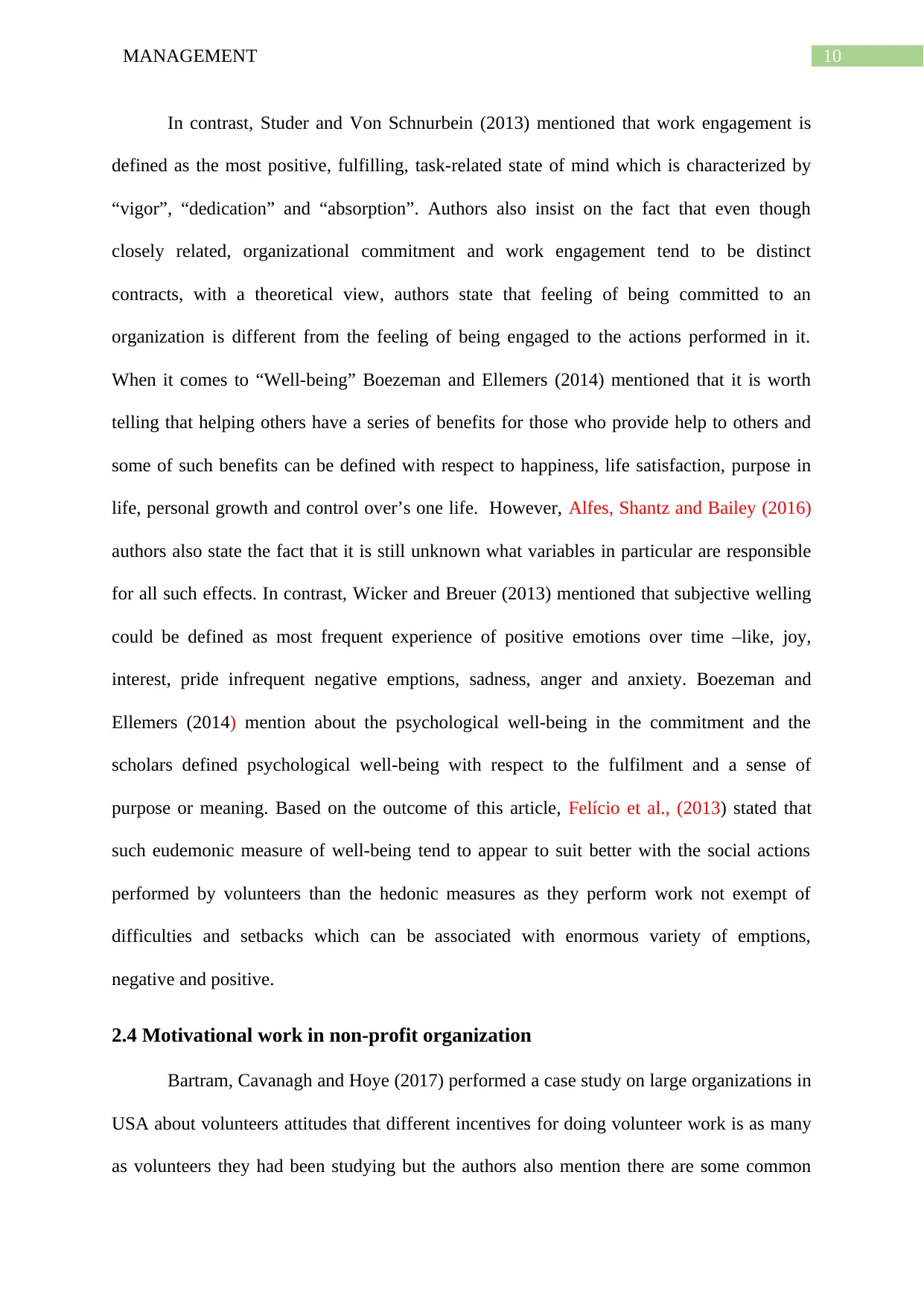
10MANAGEMENT
In contrast, Studer and Von Schnurbein (2013) mentioned that work engagement is
defined as the most positive, fulfilling, task-related state of mind which is characterized by
“vigor”, “dedication” and “absorption”. Authors also insist on the fact that even though
closely related, organizational commitment and work engagement tend to be distinct
contracts, with a theoretical view, authors state that feeling of being committed to an
organization is different from the feeling of being engaged to the actions performed in it.
When it comes to “Well-being” Boezeman and Ellemers (2014) mentioned that it is worth
telling that helping others have a series of benefits for those who provide help to others and
some of such benefits can be defined with respect to happiness, life satisfaction, purpose in
life, personal growth and control over’s one life. However, Alfes, Shantz and Bailey (2016)
authors also state the fact that it is still unknown what variables in particular are responsible
for all such effects. In contrast, Wicker and Breuer (2013) mentioned that subjective welling
could be defined as most frequent experience of positive emotions over time –like, joy,
interest, pride infrequent negative emptions, sadness, anger and anxiety. Boezeman and
Ellemers (2014) mention about the psychological well-being in the commitment and the
scholars defined psychological well-being with respect to the fulfilment and a sense of
purpose or meaning. Based on the outcome of this article, Felício et al., (2013) stated that
such eudemonic measure of well-being tend to appear to suit better with the social actions
performed by volunteers than the hedonic measures as they perform work not exempt of
difficulties and setbacks which can be associated with enormous variety of emptions,
negative and positive.
2.4 Motivational work in non-profit organization
Bartram, Cavanagh and Hoye (2017) performed a case study on large organizations in
USA about volunteers attitudes that different incentives for doing volunteer work is as many
as volunteers they had been studying but the authors also mention there are some common
In contrast, Studer and Von Schnurbein (2013) mentioned that work engagement is
defined as the most positive, fulfilling, task-related state of mind which is characterized by
“vigor”, “dedication” and “absorption”. Authors also insist on the fact that even though
closely related, organizational commitment and work engagement tend to be distinct
contracts, with a theoretical view, authors state that feeling of being committed to an
organization is different from the feeling of being engaged to the actions performed in it.
When it comes to “Well-being” Boezeman and Ellemers (2014) mentioned that it is worth
telling that helping others have a series of benefits for those who provide help to others and
some of such benefits can be defined with respect to happiness, life satisfaction, purpose in
life, personal growth and control over’s one life. However, Alfes, Shantz and Bailey (2016)
authors also state the fact that it is still unknown what variables in particular are responsible
for all such effects. In contrast, Wicker and Breuer (2013) mentioned that subjective welling
could be defined as most frequent experience of positive emotions over time –like, joy,
interest, pride infrequent negative emptions, sadness, anger and anxiety. Boezeman and
Ellemers (2014) mention about the psychological well-being in the commitment and the
scholars defined psychological well-being with respect to the fulfilment and a sense of
purpose or meaning. Based on the outcome of this article, Felício et al., (2013) stated that
such eudemonic measure of well-being tend to appear to suit better with the social actions
performed by volunteers than the hedonic measures as they perform work not exempt of
difficulties and setbacks which can be associated with enormous variety of emptions,
negative and positive.
2.4 Motivational work in non-profit organization
Bartram, Cavanagh and Hoye (2017) performed a case study on large organizations in
USA about volunteers attitudes that different incentives for doing volunteer work is as many
as volunteers they had been studying but the authors also mention there are some common
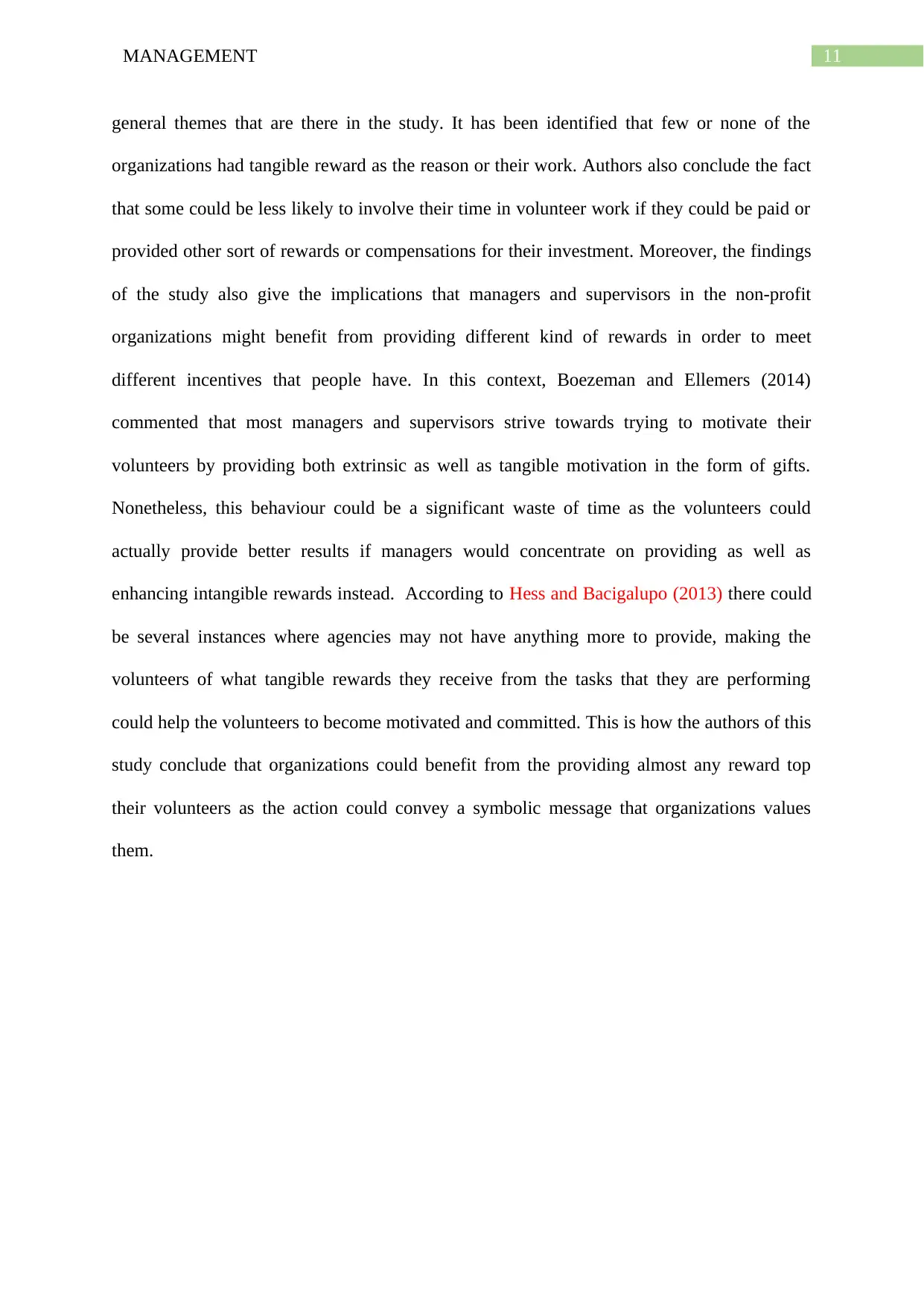
11MANAGEMENT
general themes that are there in the study. It has been identified that few or none of the
organizations had tangible reward as the reason or their work. Authors also conclude the fact
that some could be less likely to involve their time in volunteer work if they could be paid or
provided other sort of rewards or compensations for their investment. Moreover, the findings
of the study also give the implications that managers and supervisors in the non-profit
organizations might benefit from providing different kind of rewards in order to meet
different incentives that people have. In this context, Boezeman and Ellemers (2014)
commented that most managers and supervisors strive towards trying to motivate their
volunteers by providing both extrinsic as well as tangible motivation in the form of gifts.
Nonetheless, this behaviour could be a significant waste of time as the volunteers could
actually provide better results if managers would concentrate on providing as well as
enhancing intangible rewards instead. According to Hess and Bacigalupo (2013) there could
be several instances where agencies may not have anything more to provide, making the
volunteers of what tangible rewards they receive from the tasks that they are performing
could help the volunteers to become motivated and committed. This is how the authors of this
study conclude that organizations could benefit from the providing almost any reward top
their volunteers as the action could convey a symbolic message that organizations values
them.
general themes that are there in the study. It has been identified that few or none of the
organizations had tangible reward as the reason or their work. Authors also conclude the fact
that some could be less likely to involve their time in volunteer work if they could be paid or
provided other sort of rewards or compensations for their investment. Moreover, the findings
of the study also give the implications that managers and supervisors in the non-profit
organizations might benefit from providing different kind of rewards in order to meet
different incentives that people have. In this context, Boezeman and Ellemers (2014)
commented that most managers and supervisors strive towards trying to motivate their
volunteers by providing both extrinsic as well as tangible motivation in the form of gifts.
Nonetheless, this behaviour could be a significant waste of time as the volunteers could
actually provide better results if managers would concentrate on providing as well as
enhancing intangible rewards instead. According to Hess and Bacigalupo (2013) there could
be several instances where agencies may not have anything more to provide, making the
volunteers of what tangible rewards they receive from the tasks that they are performing
could help the volunteers to become motivated and committed. This is how the authors of this
study conclude that organizations could benefit from the providing almost any reward top
their volunteers as the action could convey a symbolic message that organizations values
them.
⊘ This is a preview!⊘
Do you want full access?
Subscribe today to unlock all pages.

Trusted by 1+ million students worldwide
1 out of 28